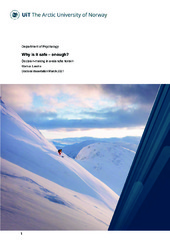Blar i forfatter "Landrø, Markus"
-
Avalanche decision-making frameworks: Classification and description of underlying factors
Landrø, Markus; Pfuhl, Gerit; Engeset, Rune; Jackson, Miriam; Hetland, Audun (Journal article; Tidsskriftartikkel; Peer reviewed, 2019-10-17)Snow avalanches are a complex phenomenon and correctly assessing avalanche danger is crucial in order to avoid accidents. To aid the decision-making process, different decision-making frameworks (DMFs) have been developed. However, each DMF assesses different factors. We identified 44 factors included in the ten most commonly used DMFs, supplemented by nine factors regarded as important by avalanche ... -
Avalanche decision-making frameworks: Factors and methods used by experts
Landrø, Markus; Hetland, Audun; Engeset, Rune; Pfuhl, Gerit (Journal article; Tidsskriftartikkel; Peer reviewed, 2019-10-31)The snowy mountains of the world attract more and more backcountry recreationalists. Besides beauty and joy, traveling in avalanche terrain can involve risk of injury and even death. A correct assessment of avalanche danger and following a correct decision is crucial. This requires a thorough evaluation of a range of factors. To aid these decisions several decision-making frameworks (DMF) have been ... -
Communicating public avalanche warnings – what works?
Engeset, Rune; Pfuhl, Gerit; Landrø, Markus; Mannberg, Andrea; Hetland, Audun (Journal article; Tidsskriftartikkel; Peer reviewed, 2018-09-20)Like many other mountainous countries, Norway has experienced a rapid increase in both recreational winter activities and fatalities in avalanche terrain during the past few decades: during the decade 2008–2017, 64 recreational avalanche fatalities were recorded in Norway. This is a 106% increase from that of the previous decade. In 2013, Norway therefore launched the National Avalanche Warning ... -
The role of avalanche education in assessing and judging avalanche risk factors
Landrø, Markus; Engeset, Rune Verpe; Pfuhl, Gerit (Journal article; Tidsskriftartikkel; Peer reviewed, 2022-07-07)Avalanche decision-making falls into two general categories; probabilistic approaches and analytical approaches. Analytical approaches have traditionally been considered applicable to experts only, as they require assessing risk factors precisely and understanding their relevance in each situation. In this study we question this assumption. We asked 1,220 amateur backcountry recreationalists how ... -
Should I Judge Safety or Danger? Perceived Risk Depends on the Question Frame
Stephensen, Matthew; Schulze, Christin; Landrø, Markus; Hendrikx, Jordy; Hetland, Audun (Journal article; Tidsskriftartikkel; Peer reviewed, 2020-04-29)Linguistic polarity is a natural characteristic of judgments: Is that situation safe/dangerous? How difficult/easy was the task? Is that politician honest/dishonest? Across six studies (<i>N</i> = 1599), we tested how the qualitative frame of the question eliciting a risk judgment influenced risk perception and behavior intention. Using a series of hypothetical scenarios of skiing in avalanche ... -
Who's at risk in the backcountry? Effects of individual characteristics on hypothetical terrain choices
Mannberg, Andrea; Hendrikx, Jordy; Landrø, Markus; Ahrland Stefan, Martin (Journal article; Tidsskriftartikkel; Peer reviewed, 2018-08-18)We use data from an online survey in Norway (N = 467, 73% male; age: M = 34, SD = 10.07) to analyze hypothetical choices in hazardous avalanche terrain. We further analyze differences in stated preference for and willingness to accept to ski relatively risky terrain. Our results suggest that risk attitudes and perception constitute important determinants for hypothetical terrain choices. We further ... -
Why is it safe – enough? Decision-making in avalanche terrain
Landrø, Markus (Doctoral thesis; Doktorgradsavhandling, 2021-10-25)The snowy mountains of the world attract an increasing number of backcountry recreationalists, but nice skiing comes with a risk. Every year about 140 people in Europe and North America lose their life in avalanche accidents. 9 out of 10 accidents are triggered by the victim or someone in their party. Therefore, improving decision-making is important. Avalanche terrain decision-making is complex ...


 English
English norsk
norsk





